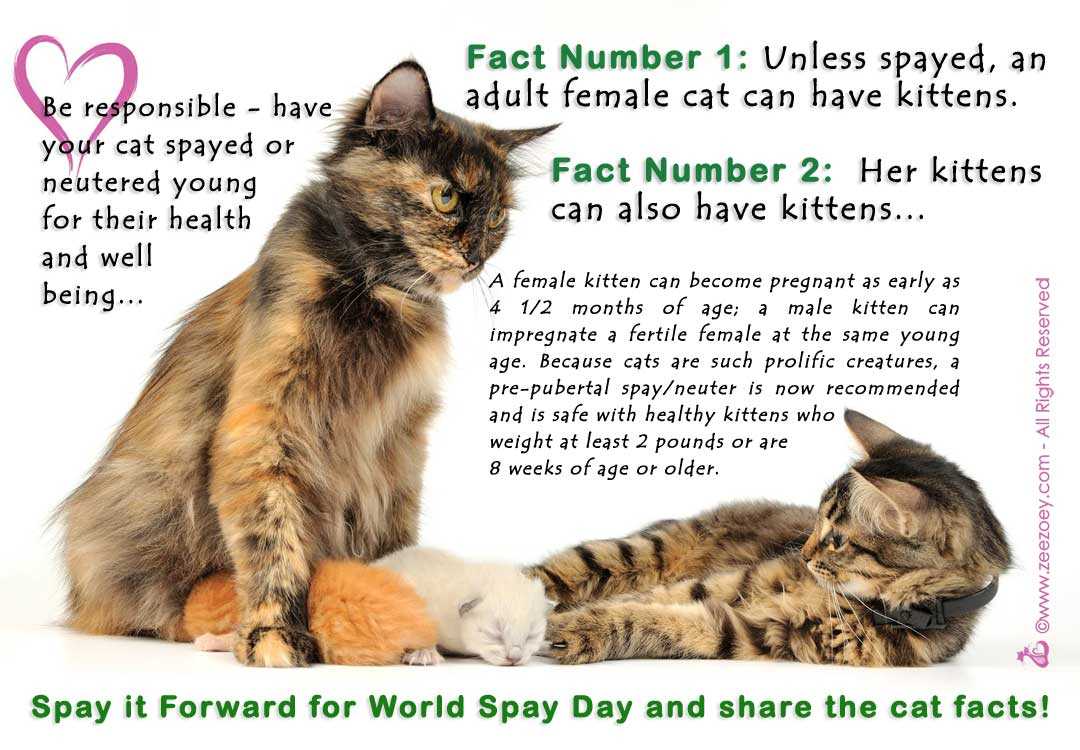At around 4 months of age, many veterinarians suggest that kittens can undergo sterilization procedures. This timeline aligns with their growth and development stages, ensuring a smoother recovery process and reducing the risk of unwanted litters.
It’s advisable to consult with a trusted veterinarian to assess the specific health and readiness of your furry companion. Factors such as weight, health status, and breed may influence the precise timing for these procedures.
By taking proactive steps at an early age, you not only contribute to reducing the stray animal population but also enhance your pet’s overall health and well-being. Early sterilization is linked to a decreased risk of certain health issues later in life.
Optimal Age for Neutering and Spaying

Neutering and spaying can be performed as early as eight weeks old, depending on the health and weight of the feline. Many veterinarians recommend this timeframe to prevent unwanted litters and to promote better health outcomes.
Factors Influencing the Decision
Weight is a significant factor; a kitten should ideally weigh at least two pounds before undergoing the procedure. Additionally, individual health assessments can influence timing, and consulting with a veterinarian is essential to determine the right moment for intervention.
Post-Procedure Care

After the operation, monitoring for any signs of complications is crucial. Keeping the recovery area quiet and comfortable will aid in healing. Also, it’s a good time to explore questions like can cats eat acai to ensure a balanced diet for your recovering friend.
Understanding the Optimal Age for Spaying and Neutering
For optimal health, I recommend scheduling the surgical procedure between 4 to 6 months of age. This timeframe helps in preventing unwanted litters while also minimizing the risk of certain health issues.
Research indicates that spaying females before their first heat cycle can significantly reduce the chance of mammary tumors and eliminate the risk of uterine infections. Males, on the other hand, benefit from the procedure by decreasing the likelihood of testicular cancer and minimizing aggressive behaviors.
Consulting with a veterinarian is key. They can assess the individual health and needs of each feline. Factors such as breed, size, and overall well-being may influence the ideal timing.
In some cases, early intervention may be advised for feral cats or those in shelters to control populations effectively. However, for household companions, following the 4 to 6-month guideline remains a solid strategy.
Post-operative care is crucial as well. Ensuring a safe and comfortable recovery environment will aid in a smooth healing process. Regular check-ups afterward will help monitor any potential complications.
Identifying Health Considerations Before the Procedure
Before undergoing the sterilization process, evaluating specific health factors is crucial. Ensure your feline friend is in good overall health. A thorough veterinary check-up should include assessments of weight, vaccination status, and any underlying medical conditions. If your companion displays signs of illness such as lethargy, vomiting, or unusual behavior, postponing the operation is wise.
Vaccination Status
Confirm that all vaccinations are up to date. Cats should receive their initial vaccines before the procedure to minimize risks during surgery. Discuss with your veterinarian about any additional vaccinations needed to protect against diseases that could complicate recovery.
Weight Management
Maintaining a healthy weight is essential. Overweight or underweight cats face higher risks during anesthesia and surgery. Regular monitoring of your pet’s diet and weight can help ensure they are at an optimal level for the operation. For more insights on a cat’s diet, check out this link: do cats actually eat mice.
Video:
At around 4 months of age, many veterinarians suggest that kittens can undergo sterilization procedures. This timeline aligns with their growth and development stages, ensuring a smoother recovery process and reducing the risk of unwanted litters.
It’s advisable to consult with a trusted veterinarian to assess the specific health and readiness of your furry companion. Factors such as weight, health status, and breed may influence the precise timing for these procedures.
By taking proactive steps at an early age, you not only contribute to reducing the stray animal population but also enhance your pet’s overall health and well-being. Early sterilization is linked to a decreased risk of certain health issues later in life.
Optimal Age for Neutering and Spaying

Neutering and spaying can be performed as early as eight weeks old, depending on the health and weight of the feline. Many veterinarians recommend this timeframe to prevent unwanted litters and to promote better health outcomes.
Factors Influencing the Decision
Weight is a significant factor; a kitten should ideally weigh at least two pounds before undergoing the procedure. Additionally, individual health assessments can influence timing, and consulting with a veterinarian is essential to determine the right moment for intervention.
Post-Procedure Care

After the operation, monitoring for any signs of complications is crucial. Keeping the recovery area quiet and comfortable will aid in healing. Also, it’s a good time to explore questions like can cats eat acai to ensure a balanced diet for your recovering friend.
Understanding the Optimal Age for Spaying and Neutering
For optimal health, I recommend scheduling the surgical procedure between 4 to 6 months of age. This timeframe helps in preventing unwanted litters while also minimizing the risk of certain health issues.
Research indicates that spaying females before their first heat cycle can significantly reduce the chance of mammary tumors and eliminate the risk of uterine infections. Males, on the other hand, benefit from the procedure by decreasing the likelihood of testicular cancer and minimizing aggressive behaviors.
Consulting with a veterinarian is key. They can assess the individual health and needs of each feline. Factors such as breed, size, and overall well-being may influence the ideal timing.
In some cases, early intervention may be advised for feral cats or those in shelters to control populations effectively. However, for household companions, following the 4 to 6-month guideline remains a solid strategy.
Post-operative care is crucial as well. Ensuring a safe and comfortable recovery environment will aid in a smooth healing process. Regular check-ups afterward will help monitor any potential complications.
Identifying Health Considerations Before the Procedure
Before undergoing the sterilization process, evaluating specific health factors is crucial. Ensure your feline friend is in good overall health. A thorough veterinary check-up should include assessments of weight, vaccination status, and any underlying medical conditions. If your companion displays signs of illness such as lethargy, vomiting, or unusual behavior, postponing the operation is wise.
Vaccination Status
Confirm that all vaccinations are up to date. Cats should receive their initial vaccines before the procedure to minimize risks during surgery. Discuss with your veterinarian about any additional vaccinations needed to protect against diseases that could complicate recovery.
Weight Management
Maintaining a healthy weight is essential. Overweight or underweight cats face higher risks during anesthesia and surgery. Regular monitoring of your pet’s diet and weight can help ensure they are at an optimal level for the operation. For more insights on a cat’s diet, check out this link: do cats actually eat mice.
Video:
At around 4 months of age, many veterinarians suggest that kittens can undergo sterilization procedures. This timeline aligns with their growth and development stages, ensuring a smoother recovery process and reducing the risk of unwanted litters.
It’s advisable to consult with a trusted veterinarian to assess the specific health and readiness of your furry companion. Factors such as weight, health status, and breed may influence the precise timing for these procedures.
By taking proactive steps at an early age, you not only contribute to reducing the stray animal population but also enhance your pet’s overall health and well-being. Early sterilization is linked to a decreased risk of certain health issues later in life.
Optimal Age for Neutering and Spaying

Neutering and spaying can be performed as early as eight weeks old, depending on the health and weight of the feline. Many veterinarians recommend this timeframe to prevent unwanted litters and to promote better health outcomes.
Factors Influencing the Decision
Weight is a significant factor; a kitten should ideally weigh at least two pounds before undergoing the procedure. Additionally, individual health assessments can influence timing, and consulting with a veterinarian is essential to determine the right moment for intervention.
Post-Procedure Care

After the operation, monitoring for any signs of complications is crucial. Keeping the recovery area quiet and comfortable will aid in healing. Also, it’s a good time to explore questions like can cats eat acai to ensure a balanced diet for your recovering friend.
Understanding the Optimal Age for Spaying and Neutering
For optimal health, I recommend scheduling the surgical procedure between 4 to 6 months of age. This timeframe helps in preventing unwanted litters while also minimizing the risk of certain health issues.
Research indicates that spaying females before their first heat cycle can significantly reduce the chance of mammary tumors and eliminate the risk of uterine infections. Males, on the other hand, benefit from the procedure by decreasing the likelihood of testicular cancer and minimizing aggressive behaviors.
Consulting with a veterinarian is key. They can assess the individual health and needs of each feline. Factors such as breed, size, and overall well-being may influence the ideal timing.
In some cases, early intervention may be advised for feral cats or those in shelters to control populations effectively. However, for household companions, following the 4 to 6-month guideline remains a solid strategy.
Post-operative care is crucial as well. Ensuring a safe and comfortable recovery environment will aid in a smooth healing process. Regular check-ups afterward will help monitor any potential complications.
Identifying Health Considerations Before the Procedure
Before undergoing the sterilization process, evaluating specific health factors is crucial. Ensure your feline friend is in good overall health. A thorough veterinary check-up should include assessments of weight, vaccination status, and any underlying medical conditions. If your companion displays signs of illness such as lethargy, vomiting, or unusual behavior, postponing the operation is wise.
Vaccination Status
Confirm that all vaccinations are up to date. Cats should receive their initial vaccines before the procedure to minimize risks during surgery. Discuss with your veterinarian about any additional vaccinations needed to protect against diseases that could complicate recovery.
Weight Management
Maintaining a healthy weight is essential. Overweight or underweight cats face higher risks during anesthesia and surgery. Regular monitoring of your pet’s diet and weight can help ensure they are at an optimal level for the operation. For more insights on a cat’s diet, check out this link: do cats actually eat mice.









